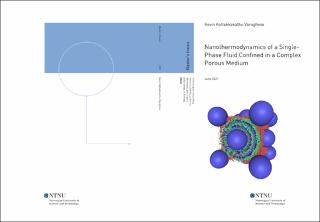| dc.contributor.advisor | Kjelstrup, Signe | |
| dc.contributor.advisor | Galteland, Olav | |
| dc.contributor.advisor | Rauter, Michael Tobias | |
| dc.contributor.author | Varughese, Kevin Kottakkakathu | |
| dc.date.accessioned | 2021-09-28T18:30:52Z | |
| dc.date.available | 2021-09-28T18:30:52Z | |
| dc.date.issued | 2021 | |
| dc.identifier | no.ntnu:inspera:77799055:36365325 | |
| dc.identifier.uri | https://hdl.handle.net/11250/2785500 | |
| dc.description.abstract | Nanotermodynamiske teorier og ideer blir her brukt på små systemer, spesifikt et porøsmedium, ved hjelp av Monte Carlo simulasjoner med Molekylær Dynamikk basert på "Grand Canonical Ensemble". Til å begynne med tester vi teorien mot spaltepore, deretter ekspanderer vi teorien og ligninene til å passe til bruk med porøsmembran. Det porøse mediumet som blir brukt her består solide partikler satt sammen som en "Face-Centered Cubic lattice". Flere tilfeller av FCC enhetscellene blir her konstruert i forhold til "Grand Canonical Ensemble" egenskaper, altså at temperatur, volum, overflate, areal og kjemiskpotensial blir kontrollert. For tilfellet hvor vi studerer spalteporet, ser vi på integral og differensial egenskaper av småsystemer, som beskrevet av Hill. For spalteporet er simulasjoner med varierende høyder og kjemiskpotensial kjørt, og resten av egenskapene ble holdt konstant. Dette lot oss studere hvordan kjemiskpotensiale og høyde påvirker småsystemer i forhold til nanotermodynamiske beskrivelser, ihvertfall for spalteporer. Vi så at vi kom til lignende resultater uavhengig av hvilken metode vi valgte å studere egenskapene. Dette viser til at det nanotermodynamiske beskrivelsen er konsistent. Deretter videreførte vi teorien til å passe med porøs medium. Vi ville beskrive integraltrykket til enfaset væske i porøs medium, ved å bruke en ny metode. Så testet vi den nye metoden ved å kontrollere for temperatur, volum og kjemiskpotensial. Deretter studerte vi hvor godt integraltrykket kan beskrives av metoden. Til slutt evaluerte vi resultatene, og det viser seg at den alternative eller nye metoden som blir beskrevet her gir tilfredstilende resultater når det sjekkes opp mot verdier fra andres arbeid. | |
| dc.description.abstract | Nanothermodynamic theories and ideas are applied to a porous medium using Monte Carlo simulations with molecular dynamics based on grand canonical ensemble. Initially the theory is tested against a slit pore, thereafter expanded upon to be used with a porous membrane where the solid particles are defined by a Face-Centered Cubic Lattice. Ensembles of FCC unit cells are constructed, following Grand Canonical ensemble properties, i.e controlled temperature, volume, surface area and chemical potential. For the slit pore, Integral and differential properties at small system scale as introduced by Hill, is looked into. Simulations are carried out with either varying chemical potential or varying height, keeping other properties constant in the case of slit pore. This lets us study the effects of chemical potential and volume on slit pores according to nanothermodynamic description of the slit pore. Regardless of the pathway chosen to describe specific properties, the results seem to be similar, suggesting the nanothermodynamic description is consistent. After testing the theory against the slit pore, we expand upon it to find an alternate route to describe the integral pressure of single-phase fluid in porous membrane. We test the new method controlling for temperature, volume and chemical potential, and study how well the integral pressure is described. After evaluating the yielded results, the alternate route described in this paper seem to give satisfactory results when compared against values from other work. | |
| dc.language | eng | |
| dc.publisher | NTNU | |
| dc.title | Nanothermodynamics of a Single-Phase Fluid Confined in a Complex Porous Medium | |
| dc.type | Master thesis | |
